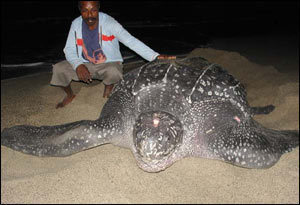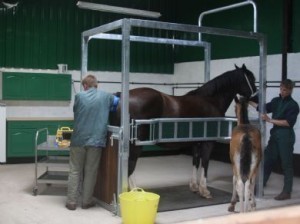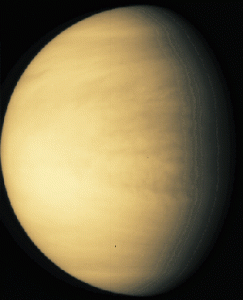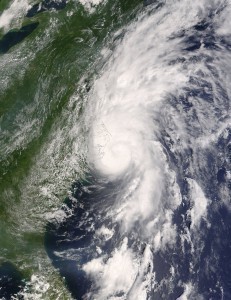Biggest Turtle
Dermochelys coriacea, the Leatherback Turtle, matures to an average  length of 1-2 m (3.3-6.6 ft) and can weigh from 250-700 kg (550-1,500 lbs). The biggest of this species ever discovered measured more than 3 m (10 ft) in length and 916 kg (2,019 lbs) in weight. This makes it not only the biggest sea turtle in existence, but also the 4th biggest modern reptile species, following those of the class Crocodilia (which include the Alligator and the Crocodile).
length of 1-2 m (3.3-6.6 ft) and can weigh from 250-700 kg (550-1,500 lbs). The biggest of this species ever discovered measured more than 3 m (10 ft) in length and 916 kg (2,019 lbs) in weight. This makes it not only the biggest sea turtle in existence, but also the 4th biggest modern reptile species, following those of the class Crocodilia (which include the Alligator and the Crocodile).
The leatherback turtle has a large teardrop-shaped body, which is the most hydrodynamic body structure among all sea turtle species. Compared to other turtles, it also has the biggest flippers in proportion to its body. Its front flippers, in particular, are known to grow as large as 2.7 m (9 ft), which are larger than the flippers of any other turtle specimen. They are so developed to easily propel the leatherback through the water as it swims in the open ocean that is its habitat. There are no claws present in both pairs of the leatherback’s flippers.
Among the notable physical traits unique to the leatherback turtle is that it does not have a bony carapace or shell as other turtles do. Rather than a bony external plate or scute, it has a thick, oily and leathery skin (hence its name) embedded with bony scale-like deposits called osteoderms. Another characteristic distinguishing it from other reptiles is the absence of Beta-keratin in their scales (Beta-keratin is responsible for giving reptile skins rigidity). Also, leatherbacks do not have any teeth, but instead have points situated on its upper lip, as well as backward spines located in its throat that enable it to swallow its food.
Considered as one of the deepest-diving marine creatures, the leatherback turtle is capable of submerging to a depth of 1,280 m (4,199 ft). And somewhat contrary to the perpetual image of the turtle as the slowest-moving animal, the leatherback turtle is actually the fastest-moving reptile species. As listed in the Guinness Book of World Records (1992 edition), it can move at a rate of 35.28 km per hour (21.92 mph) when in water. A natural swimmer, as all sea turtles are, one leatherback observed by scientists was recorded to have swum 647 days from Indonesia to the US, covering a distance of 20,000 km (12,427 mi).
The sole living species of its genus Dermochelys, the leatherback turtle is endangered by threats both natural and man-made. Although leatherbacks do not have many natural predators as adults, young leatherbacks tend to be susceptible to predation, particularly from birds and small mammals that dig up turtle nests for the eggs, waders (shorebirds) and crustaceans preying on newly-hatched leatherbacks scuttling to the sea, and the cephalopods and predatory fish waiting for the hatchlings that do make it to the water.
While there is very little demand for catching the leatherneck turtle itself (owing to the high oil and fat content in its flesh), its population is still in danger of decline due to the illegal harvesting and trade of sea turtle eggs around the world. This is particularly prevalent in Southeast Asian countries such as Malaysia and Thailand. Add to that the threat posed by pollution and other hazards to the environment. The leatherback turtle plays a no-less important part in the eco-system, as it keeps the jellyfish population under control. So it is in our best interests to conserve the leatherbacks in order to preserve the delicate balance of our ecology.





